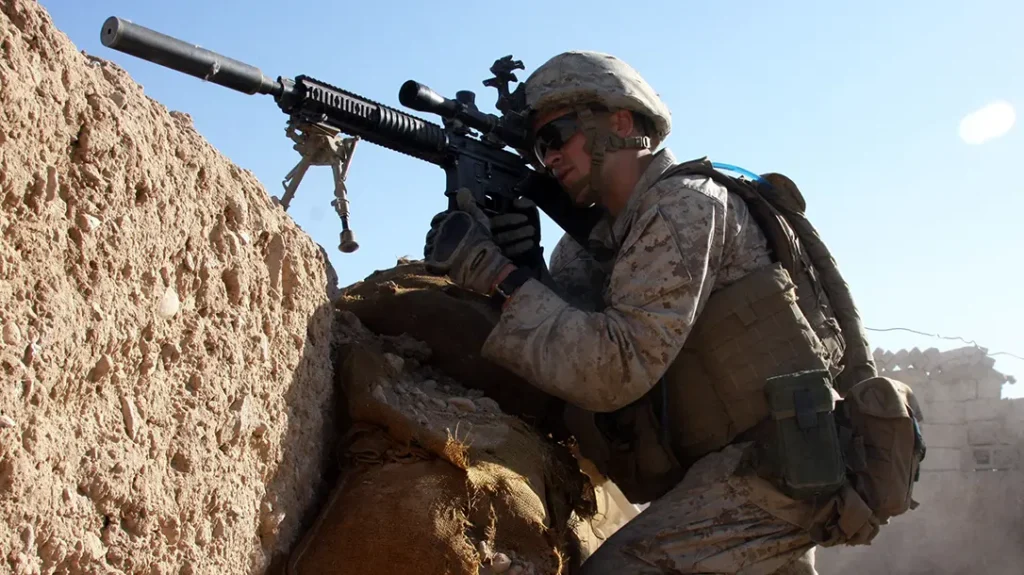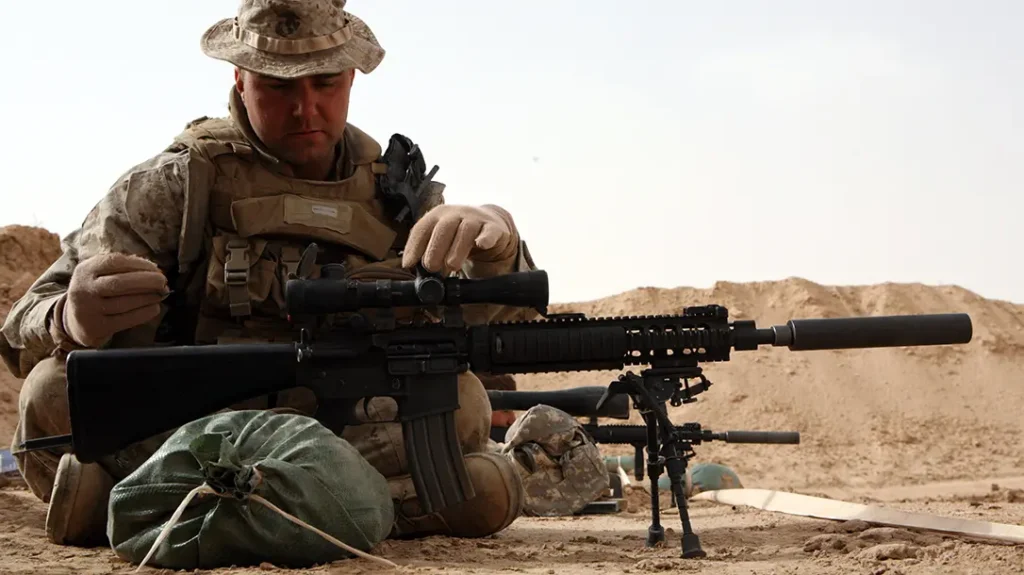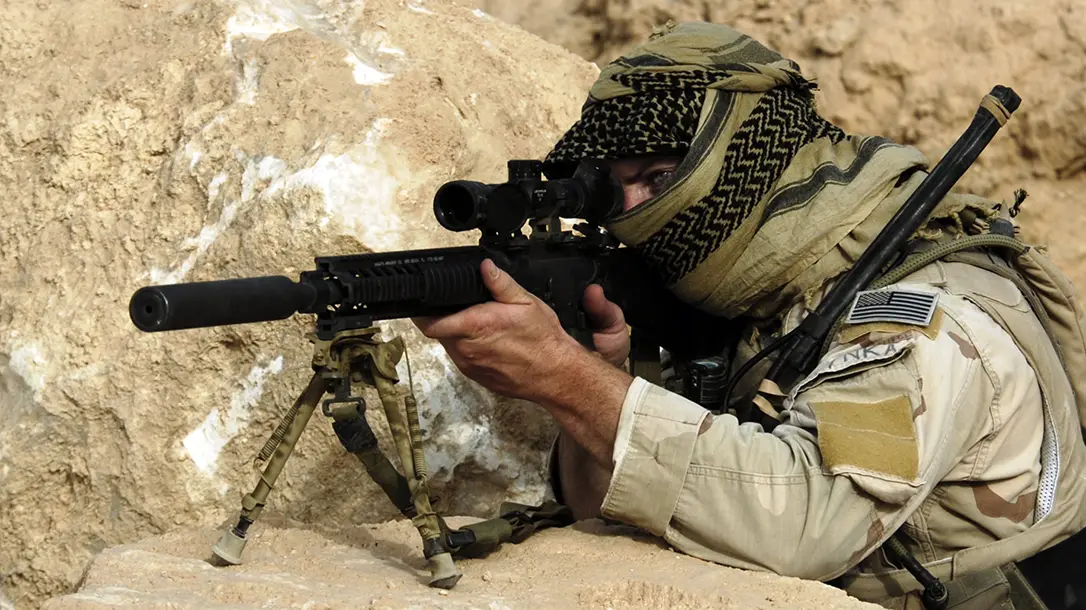The MK12 SPR was created to fill a gap in the arsenal of special operations between the M4 and full sniper rifles. This concept had multiple variations through its service life with the main variants being the Mod 0, Mod H, and Mod 1. The weapon was a complete system that factored in the rifle, optic, suppressor, and ammunition. This concept, developed by operator feedback, became the most lethal precision rifle in U.S. history.
MK12 SPR History
The MK 12 was developed by Naval Special Warfare Center Crane Division for U.S. special operations units. The first runs of MK12 Mod 0 and Mod 1 rifles were built by Crane contractors Vince Jiga and John Miller. Originally the MK12 was designated as the Special Purpose Receiver, which later changed to the Special Purpose Rifle. The design was requested by both Navy and Army special operations to find a weapon that was more effective at distance than the M4 but less cumbersome than the SR-25. While there were commonalities between the variants, there were also differences that were influenced by the end users.
During the design process multiple issues were identified and addressed. The first issue being the length of the M4 flattop upper receiver limited the use of vertical rings, so an ARMS Inc. #38 rail was used to obtain proper eye relief on the Mod 0 and Mod H. This also added rigidity to the PRI forend used on these models. The Mod H was designed by Master Sgt. (R) Steve Holland for 5th Special Forces Group. This design incorporated a 16-inch barrel and different ARMS Inc. rail than the Mod 0. To reduce gas blowback, the PRI Gas Buster charging handle was used to seal the back of the receiver. The Gas Buster also served as a patented safety device. The Mod 1 utilized the Knight’s Armament free float RAS quad rail and back-up iron sights.
Advertisement — Continue Reading Below

SOPMOD Legacy
This program grew out of the SOPMOD block 1 program originally as the SPR, SPR/A, SPR/B, and the NSWF Recce Rifle. The receivers were equipped with Douglas or Kreiger stainless barrels with either 18- or 16-lengths depending on the variant. They were equipped with the collar and muzzle device to host the Ops Inc. 12th model suppressor. When the program moved from a receiver to a complete rifle, the M16 A1 lowers were used. The Knight’s Armament two-stage trigger was selected for the initial rifles; however, many were later retrofitted with Geissele triggers. After extensive testing the first MK12 rifles were issued in 2002 and were used extensively in the Global War on Terror until 2017 when the program was abandoned. During military use, the MK12 was modified by end users and fitted with a variety of stocks, grips, bipods, and optics.
The Mod 1 and Mod H were primarily used by U.S. Army Special Forces, while the Mod 1 was primarily used by U.S. Army Rangers, NSW, and later Marine Corps designated marksmen.
Advertisement — Continue Reading Below
Ammo
A big component of the system was the MK262 ammunition. The MK262 was loaded by Black Hills using the 77-grain Sierra Match King bullet. The MK262 Mod1 changed the bullet to the 77-grain Sierra Match King with cannelure. The cannelure provides a consistent crimp on the bullet which gave the ammo more consistent performance due to problems with bullet set back on the MK262 Mod 0. Although the bullet was designed for accuracy, end users observed the enhanced terminal performance from not only the MK12 SPR but also from the Mk18 CQBR. The Mk12 loaded with Mk262 has a maximum effective range of 700 meters (770 yards).
Optics
The optics that were issued with the Mk12 were the Nightforce 2.5-10×24, Leupold MK4 MR/T 3-9, or Leupold 2-8. Many were retrofitted by units with Leupold M3 Ultra and MK 4 3.5-10 optics taken from other sniper rifles in the unit. These were not the only optics used on the platform. Due to units buying a variety of optics with operational funds, many different optics found their way onto a MK12, but these were the issued optics used on the MK12 platform.

Advertisement — Continue Reading Below
Suppressor
The Ops Inc. 12th model suppressor used on the MK12 is a departure from traditional suppressor in that it is a reflex suppressor that has a muzzle device and separate barrel collar. The suppressor sits over the barrel and centers on the barrel collar. This allows the 8.8-inch suppressor to only extend 6.25 inches past the muzzle. The 12th model suppressor is noted for being one of the quietest suppressors for a 5.56 platform. Allen Engineering and Otter Creek Labs currently manufacture this model of suppressor as the AEM-5 and OCM-5 respectively.
Shooting Impressions
I was able to go to the range and fire a Mod 0 and Mod 1. The Mod 0 was built by MSTN and used a Surefire RC2 mini. The Mod 1 was built by Centurion Arms and used a AEM-5 suppressor. The ammo used was MK262 provided by Pinnacle Precision.
Due to the rifle-length gas system and rifle buffer system, both rifles had very little recoil and allowed for extremely fast follow-up shots. The accuracy of both rifles were outstanding. The MSTN Mod 0 was routinely holding .75 MOA, and the Mod 1 was holding consistent 1 MOA groups. I have owned this Mod 0 for 15 years and after countless rounds it is still holding sub MOA.
Advertisement — Continue Reading Below
MK12 SPR: Final Shots
The MK12 is a perfect example of necessity breeding innovation. The adaptability of the weapon allowed service members to conduct operations without the need to carry a sniper rifle and entry weapon. Using commercial, off-the-shelf solutions, the process of finding a workable solution was sped up dramatically. The modularity of the M4 also allowed carrying an M4 or MK18 and swapping the upper out when the ability to shoot longer ranges was needed. Many people who used the rifle overseas, including myself, greatly appreciated the enhanced capability of the MK12 platform, especially in urban environments.
























